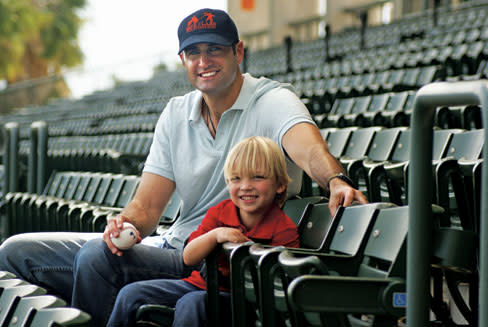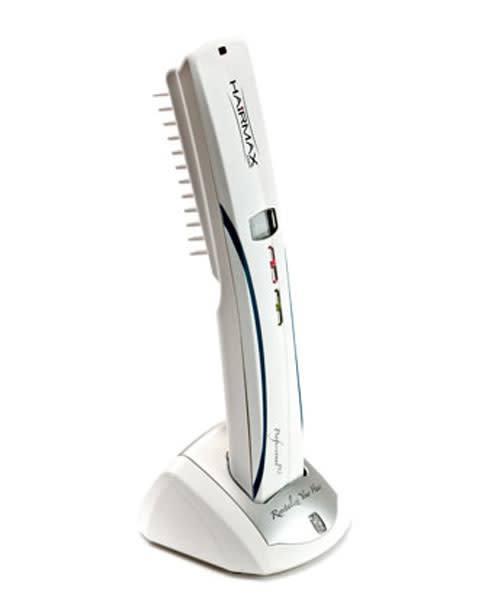Sarasota Health News: July 2014

Miracle Belt
A former Orioles pitcher develops a device that helps disabled children.
As detailed in the new book, Playing Catch with Destiny, former pro baseball pitcher Matt Bruback, who moved to Sarasota through the Orioles organization, turned his own childhood sensory problem and an athletic career demanding body awareness into a device that can aid children with any number of developmental disorders. The Miracle Belt stemmed in part from athletes’ and trainers’ use of weights and sandbags to develop proprioception, or body awareness and the engagement of particular muscles, while strengthening balance and coordination. But for children with Down syndrome, movement disorders and even autism and ADHD, who can suffer from muscle weakness and coordination issues, the belt can make a big difference in everyday function.
Operating in a similar way to weighted therapy vests, the Miracle Belt concentrates its weight around the lower core, requiring less bulk, less weight and a cooler, more comfortable fit while still making a huge difference in how children learn to coordinate their movements and strengthen their muscles. There’s also a larger Sensory Belt for older children. Available through miraclebelt.com.
Tremors? There’s an App for That.
NeuroChallenge’s Dr. Dean Sutherland shares his favorite apps for monitoring tremors in Parkinson’s patients, as well as people affected by a number of other neurological conditions, from MS to hypothermia.
Tremor Tracer
Helps clinicians assess fine motor control by conducting and recording the results of three primary writing/drawing tests. Available for iPhone. touchdx.com/solutions/tremortracer
Tremor Test
Uses the phone’s accelerometer to create a graph of the amplitude and frequency of tremors. Available for iPhone. tremortest.com
Lift Pulse (for Orthostatic tremors)
From the makers of Liftware stabilizing technology for utensils and other tools, Lift Pulse, like Tremor Test, measures and monitors tremor activity through the phone’s accelerometer. Available for both iPhone and Android. liftlabsdesign.com

Hair Today…
Men have long confronted the issue of hair loss, but for women, the problem can be just as troubling. One potential treatment for both sexes is the HairMax Laser Comb, currently available through The Ritz-Carlton, Sarasota. The relatively simple technology works by projecting a laser onto the hair follicles to stimulate growth. The Ritz-Carlton spa pros also help train clients in performing the treatments, which can then be done at home, three times a week, for eight to 15 minutes a session.
In clinical studies performed by medical centers and totaling 460 participants, more than 90 percent of HairMax users experienced “significant hair growth”—about 150 additional hairs per square inch.
Potential Causes of Female Hair Loss
Skin disease
Vitamin deficiency, especially iron or B vitamins
Hormonal changes, especially caused by pregnancy or menopause
Autoimmune disease
Medications
Stay Mindful
What it is: “Paying attention in a particular way: on purpose, in the present moment, nonjudgmentally,” according to John Kabat-Zinn, an MIT molecular biology grad who developed the modern-day mindfulness movement in 1979. While meditation is often associated with various spiritual practices, “You can practice mindfulness without changing religions,” says Nancy Saum, who emphasizes secular mindfulness practices at downtown’s Sarasota Mindfulness Institute (sarasotamindfulness.org). “It’s present-moment awareness.”
How you do it: A stereotypical introduction to mindfulness is the raisin exercise: An instructor guides you through the examination of a single raisin with all your senses; after looking at it, feeling and smelling it, you eat the raisin very deliberately to recognize texture and flavor and any other factors that might be present.
Focusing on breathing is also a common mindfulness technique; other exercises might involve acknowledging the process of movement like walking—the feel of the ground against various parts of your foot, the moment-by-moment changes, weight transfer, etc. Those exercises often involve slowing down, especially in the beginning. “You do everything slowly so you can take in the complexity,” says Saum, who also offers mindful movement classes like qigong and yoga in addition to guided meditation.
The “nonjudgmental” part of Kabat-Zinn’s definition of mindfulness is especially important—and often the hardest to grasp, says Saum. When people’s minds wander, they tend to think, “I’m no good at this.” The key, she says, is to acknowledge those thoughts as perfectly natural, and then to return your focus to the present moment.
What it does for you: Kabat-Zinn famously used mindfulness to treat chronic pain, among other medical ailments. Nowadays, it’s used for everything from dietary therapy to sports performance visualization to education and professional settings. (There’s even a group in Congress that meets for mindfulness sessions.) When discussing mindful eating, Saum says students sometimes remark, “If I ate everything this way, I wouldn’t eat as much.” Practitioners often use mindfulness to go to sleep, focusing on breathing and other methods to “check in with our bodies,” says Saum.
But first and foremost, mindfulness practice can have an immediate effect on your overall health simply by reducing stress and anxiety. The brain has a tendency to divert focus toward the past or the future; mindfulness guides it away from those stressors. “Our body thinks whatever we’re worrying about is actually happening,” says Saum. “Whenever we’re completely in the present moment, time kind of expands. That’s a place where stress doesn’t exist.”
When East Meets West
While they’ve already mastered their own set of diagnostic and treatment standards and procedures, practitioners of traditional Chinese medicine (TCM) also need an understanding of Western medical testing, in order to bridge the gap for patients seeking both types of care. Christina Captain, a Sarasota-based acupuncturist and doctor of Oriental medicine, partnered with a Western medicine physician to write Common Laboratory Tests Used by TCM Practitioners, subtitled “When to Refer Patients for Lab Tests and How to Read and Interpret the Results.” Designed as a reference for TCM classroom and clinic settings, the book covers symptoms that frequently present in TCM practices in order to familiarize practitioners with Western medical terminology and tests. It was released this year and is available on Amazon.
For more Sarasota health news, click here. >>
This article appears in the July 2014 issue of Sarasota Magazine. Like what you read? Click here to subscribe. >>



